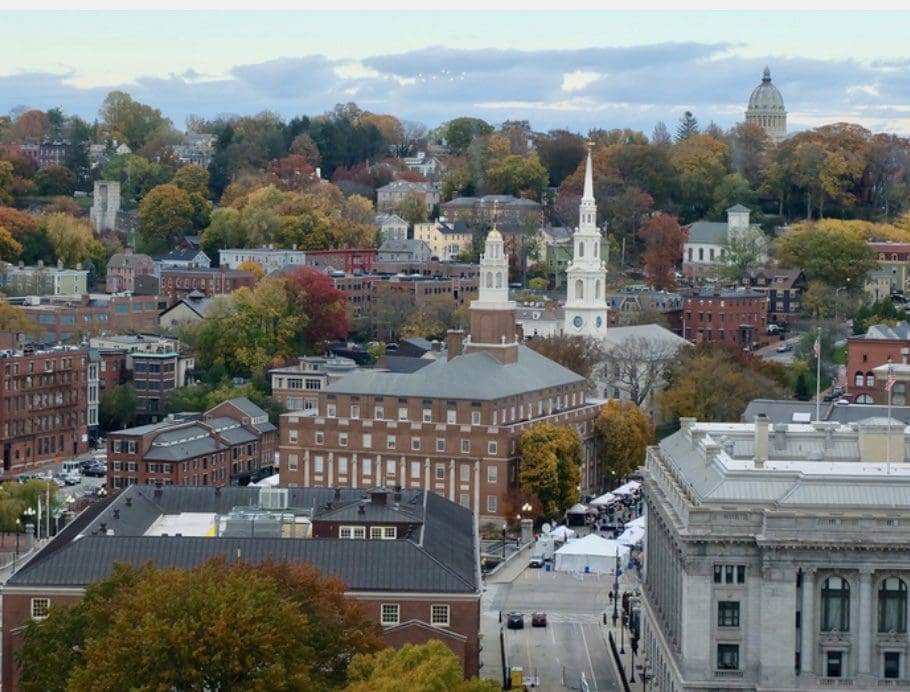Search Posts
Recent Posts
- Rhode Island Legislature Highlights Accomplishments for the 2025 Session June 25, 2025
- Sports in RI: Cody Tow, Volleyball Past, Present and Into His Future – John Cardullo June 25, 2025
- Need a Break? Time for Sour Grapes – Tim Jones June 25, 2025
- Rhode Island Weather Forecast for June 25, 2025 – Jack Donnelly June 25, 2025
- It is what it is: Commentary on 6.25.25 with Jen Brien June 25, 2025
Categories
Subscribe!
Thanks for subscribing! Please check your email for further instructions.

The Future of Providence. Trashing the city’s heritage.
By David Brussat, Architecture Here and There
That’s a good word for the bad future of Providence if the erosion of its historic character continues at its current pace. In “Say no to ugly buildings,” an Oct. 28 op-ed for the Providence Journal, I listed the buildings that have opened lately in or near downtown. Here is that list:
In just the last couple of years alone, eight major new buildings have been completed in and near downtown, including the Wexford Innovation Center in the I-195 corridor, the River House apartments near the Point Street Bridge, the first of two proposed Edge College Hill residential towers on Canal Street, the low-rise Commons at Providence Station condos along the Moshassuck River in Capital Center, a Homewood Suites Hotel on Exchange Street, a Marriott Residence Inn on Fountain Street, a Woodspring Suites Hotel just outside of downtown on Corliss Street, and a large RISD dormitory near Prospect Street on College Hill.
All of these buildings reject the historical character of Providence, either purposely or with a sort of cocky ineptitude. They follow a decade in which all but one building, the lovely Nelson Fitness Center at Brown University, were designed as if to purposely trash the city’s heritage. Providence’s civic leaders are crying “Yes!” to ugly buildings, ignoring mandates in city regulations that historical character be respected.
Incomprehensibly, the same Nelson financed an “entrepreneurship center” in a piously ugly contemporary building finished last year on Thayer Street, ending a phase of new traditional buildings there. A deep foundation has been dug for Brown’s performing arts center in a starkly modernist design. Two fashionable East Side educational institutions, the Moses Brown School and the Lincoln School, have recently erected buildings that shred historical character at prominent locations on Hope Street and Blackstone Boulevard. The grounds of stately mansions on or near Blackstone are being eyed by developers for subdivision, which risks not just the estate but the entire neighborhood – eroding not just beauty but property values. Just look at what happened to the Bodell estate. The mansion of the Nicholson-Beresford estate on Blackstone was saved, but its romantic caretaker’s cottage and playhouse are history, and five or six houses of dubious desirability (most likely un-) are planned. The developer of the Bodell estate put a modernist house last, no doubt disturbing those who bought the first four traditional houses.
With the economy humming, what seems like a record number of teardowns on the East Side, accomplished or proposed, raises even more anxiety. The aquarium shop with the delightful mural of the deep sea on its Wickenden Street façade was demolished late last year. I hear the new owner wants to build something exciting in its place. Uh-oh. Across the street and up a block, the splendid colonial at 312 Wickenden (c. 1857), home to the dear Duck & Bunny snuggery, is said to be on the chopping block. (My sourcing on the D&B is top-notch, but only a major renovation that started last March is evident online.) Three old houses, at least one of them fine, may be sacrificed for a proposed hotel at Angell and Brook that is intended to look traditional, but so far two successive designs have been disappointing.
A host of other teardowns were cited in a November GoLocalProv piece, “East Side sees flood of teardowns as average house price tops $560,000.”
[Property broker Sally] Lapides says that Providence will benefit from the newer structures.
“What it says about the area is that it is highly desirable, there is a demand for new construction, people want to invest in Providence and there are people with money who are investing in our city. The new structures will bring in more tax revenue because the assessments will be higher on the new architecture,” says Lapides.
Of course, the area might not be highly desirable for long if Providence continues to shoot itself in the foot.
The “flood” includes a teardown near my house, off Hope; fortunately, that house is slated to be replaced by two relatively traditional duplexes. When a landowner razes an old building, the cost of demolition usually comes out of what is spent on the new one. Since the 1950s and ’60s, when old buildings have been torn down and replaced by new buildings, architectural quality has almost always suffered, whether the new buildings are modernist or traditional – the latter often by architects whose exclusively modernist education means they don’t understand traditional design techniques. In virtually the blink of an eye, it could no longer be assumed (as it had been for centuries) that a new building would be superior to what it replaced.
The anxiety stirred by this phenomenon caused historical preservation to shift from a hobby to a mass movement in less than two decades, not just in Providence but across the country and much of the globe. Preservationists saved many historic buildings, but for many years have been uninterested in protecting the settings of those old buildings by promoting new traditional architecture – which is considered déclassé by professional preservationists, whose livelihoods exist because of traditional architecture. You might think preservationists make strange bedfellows with modernists. Alas, you would be wrong. If members of preservation groups knew what their boards and staffs think of their design preferences, memberships would halve overnight.
As a city like Providence expands, pressure to ignore preservationists and small property owners rises among city planning offices and developers. Meanwhile, passion naturally flags among those fighting the municipal development axis. They suspect they have no real allies. Hence the declining historical character in Rhode Island’s capital.
How long will it take for Providence’s streetscapes to be so pockmarked by modernist or bad-trad buildings that its beauty is lost? At this rate, I’d say no more than ten years.
It’s not that every modernist building is necessarily a bad one, though almost all of them are; but even a good one is sure to erode the cohesion of a block of traditional buildings – which, because they arise from gentle evolution spanning hundreds of years, fit together admirably even when they are stylistically different.
The good news is that the old commercial district of downtown Providence, known by some as Downcity (it doesn’t mean the entire downtown, please!), has almost entirely escaped the trends described up above. An unofficial moratorium on major teardowns in the commercial district started in 1979 (after the district’s Hoppin Homestead Building was razed) and ended in 2005 when the Providence National Bank was demolished in 2005. Most of the teardown sites of the past decade and a half remain vacant: that is, they remain opportunities to do the unexpected and build nice buildings instead. And only one major new building opened in the commercial district – the delightful pavilion at Grace Church, completed in 2017. Plus, two new traditional buildings of brick by Buff Chace are expected to open next year – one on the old Journal parking lot and another adding to a string of old buildings being renovated on Westminster.
The bell has already tolled for the city’s two new development districts, Capital Center (1978) and the I-195 corridor (2011). They are beyond redemption, even though four reasonably competent new traditional buildings in Capital Center – Providence Place, the Westin, its addition, and the Marriott Courtyard – showcased how major development could maintain the city’s historical character. These models were ignored, of course, there and elsewhere in the city. What else is new?
So far as I know, there are no blotches of God’s wrath on architecture on the boards for the old commercial district of downtown, whose historical fabric remains the best of any mid-sized city in the United States.
But shhh! Let’s not give anyone any ideas!
Photo: View across Providence’s old downtown and up College Hill. (sprudge.com)
To read this article in its entirety: https://architecturehereandthere.com/2020/01/15/the-future-of-providence

David Brussat – My freelance writing and editing on architecture and others addresses issues of design and culture locally and globally. I am a member of the board of the New England chapter of the Institute of Classical Architecture & Art, which bestowed an Arthur Ross Award on me in 2002. I work from Providence, R.I., where I live with my wife Victoria, my son Billy and our cat, Gato. If you would like to employ my writing and editing to improve your work, please email me at my consultancy, dbrussat@gmail.com, or call (401) 351-0457 https://architecturehereandthere.com/
